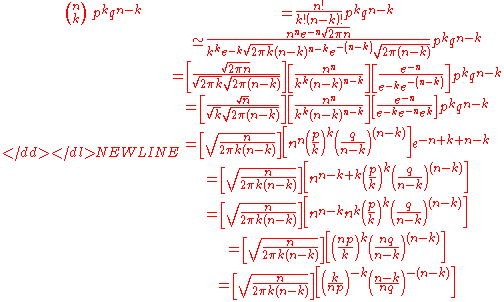
De Moivre–Laplace theorem
Encyclopedia
In probability theory
, the de Moivre–Laplace theorem is a normal approximation to the binomial distribution. It is a special case of the central limit theorem
. It states that the binomial distribution of the number of "successes" in n independent
Bernoulli trial
s with probability p of success on each trial is approximately a normal distribution with mean np and standard deviation , if n is very large and some conditions are satisfied.
, if n is very large and some conditions are satisfied.
The theorem appeared in the second edition of The Doctrine of Chances
by Abraham de Moivre
, published in 1738. The "Bernoulli trials" were not so-called in that book, but rather de Moivre wrote about the probability distribution
of the number of times "heads" appears when a coin is tossed 3600 times.
in the sense that the ratio of the left-hand side to the right-hand side converges to 1 as .
.
or:
Thus
Probability theory
Probability theory is the branch of mathematics concerned with analysis of random phenomena. The central objects of probability theory are random variables, stochastic processes, and events: mathematical abstractions of non-deterministic events or measured quantities that may either be single...
, the de Moivre–Laplace theorem is a normal approximation to the binomial distribution. It is a special case of the central limit theorem
Central limit theorem
In probability theory, the central limit theorem states conditions under which the mean of a sufficiently large number of independent random variables, each with finite mean and variance, will be approximately normally distributed. The central limit theorem has a number of variants. In its common...
. It states that the binomial distribution of the number of "successes" in n independent
Statistical independence
In probability theory, to say that two events are independent intuitively means that the occurrence of one event makes it neither more nor less probable that the other occurs...
Bernoulli trial
Bernoulli trial
In the theory of probability and statistics, a Bernoulli trial is an experiment whose outcome is random and can be either of two possible outcomes, "success" and "failure"....
s with probability p of success on each trial is approximately a normal distribution with mean np and standard deviation
 , if n is very large and some conditions are satisfied.
, if n is very large and some conditions are satisfied.The theorem appeared in the second edition of The Doctrine of Chances
The Doctrine of Chances
The Doctrine of Chances was the first textbook on probability theory, written by 18th-century French mathematician Abraham de Moivre and first published in 1718. De Moivre wrote in English because he resided in England at the time, having fled France to escape the persecution of Huguenots...
by Abraham de Moivre
Abraham de Moivre
Abraham de Moivre was a French mathematician famous for de Moivre's formula, which links complex numbers and trigonometry, and for his work on the normal distribution and probability theory. He was a friend of Isaac Newton, Edmund Halley, and James Stirling...
, published in 1738. The "Bernoulli trials" were not so-called in that book, but rather de Moivre wrote about the probability distribution
Probability distribution
In probability theory, a probability mass, probability density, or probability distribution is a function that describes the probability of a random variable taking certain values....
of the number of times "heads" appears when a coin is tossed 3600 times.
Theorem
As n grows large, for k in the neighborhood of np we can approximatein the sense that the ratio of the left-hand side to the right-hand side converges to 1 as
 .
.Proof
According to Stirling's formula, we can replace the factorial of a large number n, with the approximation:or:
Thus
-

Now, let-

-
 and
and 
-
 and
and 
-

Now, consider the first square bracket term.-

Now, consider the term in the second square bracket.
The above conversion is based on the fact that the natural logarithm function, if considered as a real-valued function of a real variable, is the inverse function of the exponential function, leading to the identity given below:
Now, consider the natural logarithm term.-

Now, using the following two series we will solve the above natural logarithm:-
and-

-

because
and so-

We can ignore the terms where the power of x is greater than 3 in the above expansion, since x approaches 0 as n gets large, because x is proportional to , and
, and  →
→  .
.

Now,
Thus,
and the result is proved. -
-
-
-
-


















